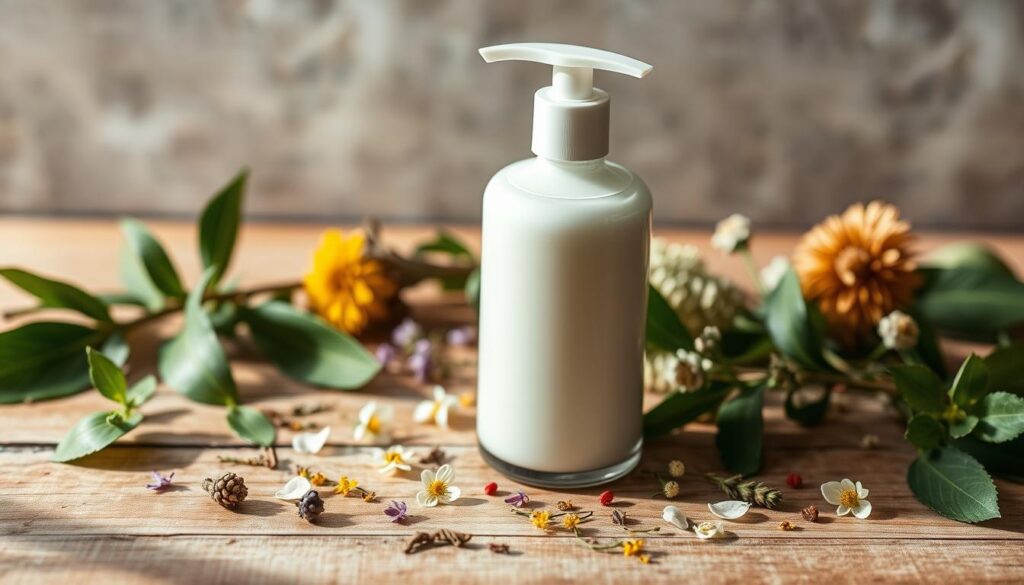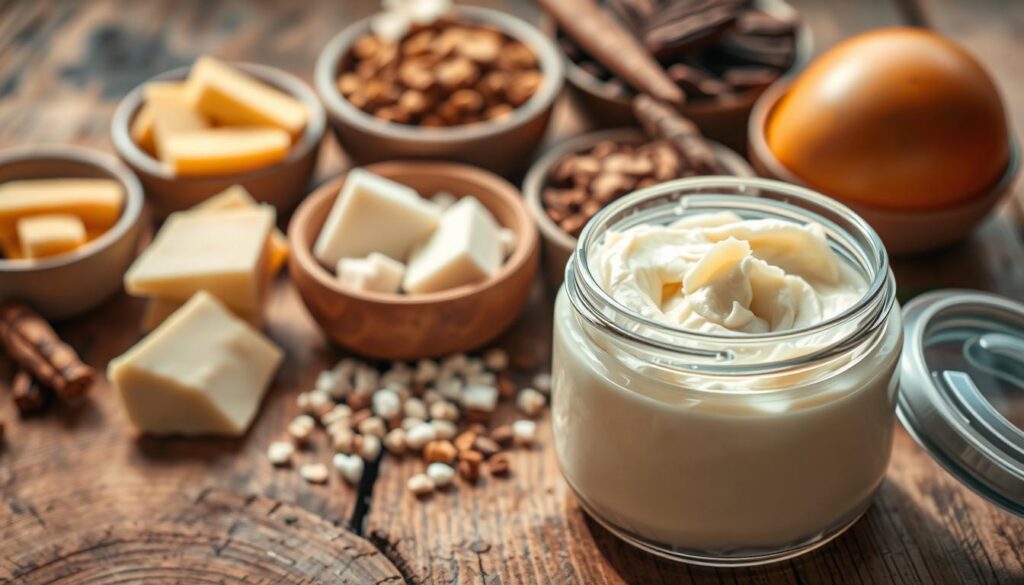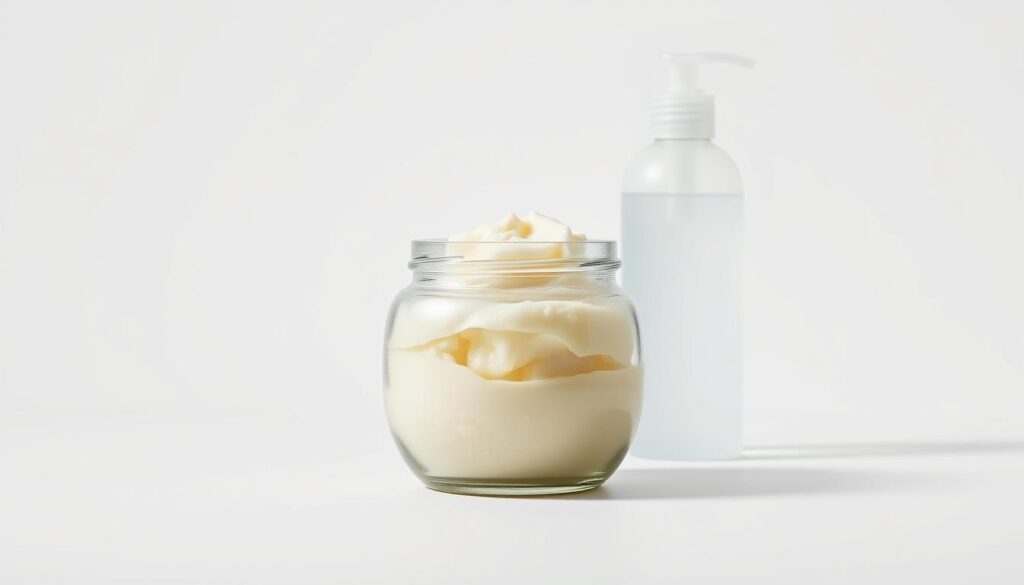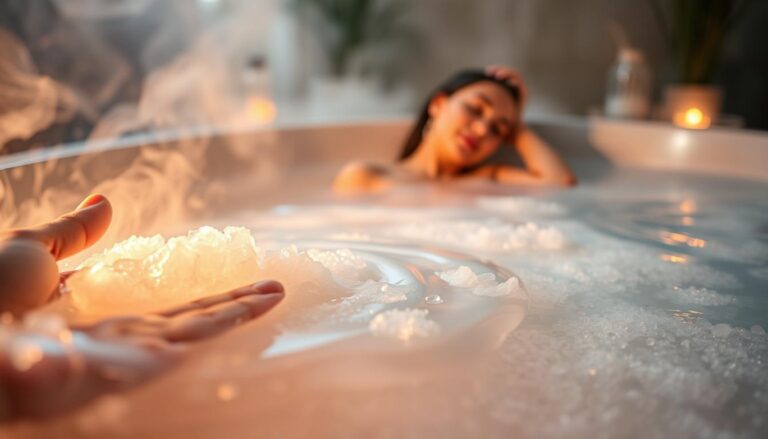At Glowskinhub.com, we believe beauty isn’t just a look—it’s a feeling

Body lotion vs body butter: Which one to use?
Choosing the right moisturiser is crucial for a healthy skincare routine. With numerous options available, deciding between a body lotion and a body butter can be overwhelming.
Understanding your Skin type is key to making the right choice. Dry Skin benefits from rich, intense hydration, while normal to oily Skin requires a lighter touch.
Selecting the ideal moisturiser can make a significant difference in how your Skin looks and feels.
Key Takeaways
- Understand your Skin type before choosing a moisturiser.
- Rich moisturisers suit dry Skin, while lighter options are better for normal to oily Skin.
- A good moisturiser is essential for a healthy skincare routine.
- Different Skin types have different moisturising needs.
- Moisturiser choice can significantly impact Skin health.
Understanding body moisturisers
Moisturising is a crucial step in any skincare routine, playing a vital role in maintaining healthy, hydrated Skin. It is essential to understand the basics of body moisturisers to make informed decisions about skincare.
The importance of body hydration
Body hydration is vital for maintaining Skin elasticity and suppleness. Proper hydration helps to prevent dryness and irritation, keeping the Skin feeling soft and comfortable. Dehydrated Skin can lead to various issues, including dryness, itchiness, and even infections.
Different types of body moisturisers available
There are various types of body moisturisers available, including lotions, butters, creams, and oils. Each type has its unique characteristics and benefits, catering to different Skin types and needs. For instance, lotions are lightweight and easily absorbed, while butters provide intense hydration.

How moisturisers affect Skin health
Moisturisers play a significant role in maintaining Skin health by locking in moisture, protecting the Skin from environmental stressors, and supporting the Skin’s natural barrier function. Regular moisturising can help to improve Skin texture, reduce the appearance of fine lines, and enhance overall Skin health.
What is body lotion?
Body lotion is a staple in many skincare routines, but what exactly is it? It is a type of moisturiser designed to hydrate and nourish the Skin, leaving it feeling soft and supple.
Composition and key ingredients
Body lotions typically consist of a mixture of water, emollients, and humectants. Key ingredients often include glycerin, ceramides, and various oils that help to lock in moisture. Some lotions may also contain additional ingredients such as vitamins and antioxidants to provide extra benefits.
For instance, lotions designed for oily Skin may include ingredients like salicylic acid or tea tree oil, which help to control oil production and reduce acne.

Texture and consistency
One of the defining characteristics of body lotion is its texture and consistency. Unlike body butters, lotions are generally lighter and more fluid, making them easy to apply and absorb quickly into the Skin.
This makes them particularly suitable for daily use, especially in warmer weather or for individuals with oily Skin who may find thicker moisturisers too heavy.
How body lotions work on the Skin
Body lotions work by creating a barrier on the Skin’s surface that prevents moisture loss. They help to replenish the Skin’s natural moisture barrier, leaving it feeling hydrated and protected.
As
“A good body lotion can make a significant difference in how your Skin feels throughout the day.”
Regular use can lead to softer, more resilient Skin that is better equipped to withstand environmental stresses.
What is body butter?
The primary function of body butter is to provide a barrier on the Skin’s surface that prevents moisture loss. Body butter is a rich and nourishing moisturizer that is particularly beneficial for dry, dehydrated, or damaged Skin.

Composition and key ingredients
Body butters are typically made from a blend of natural ingredients, including shea butter, cocoa butter, and coconut oil, which are known for their moisturizing properties. These ingredients are rich in vitamins and fatty acids that help to nourish and protect the Skin.
A typical composition of body butter may include:
| Ingredient | Benefits | Concentration |
|---|---|---|
| Shea Butter | Moisturizes and nourishes | 30% |
| Cocoa Butter | Improves Skin elasticity | 20% |
| Coconut Oil | Hydrates and protects | 50% |
Texture and consistency
Body butters have a thick and creamy texture, which is much richer than body lotions. This texture allows them to stay on the Skin’s surface longer, providing an intense dose of moisture.
How body butters work on the Skin
Body butters work by creating a protective barrier on the Skin’s surface that locks in moisture. This barrier not only prevents moisture loss but also protects the Skin from environmental stressors, such as dry air and cold weather, making it an ideal moisturizer for dry Skin conditions.
Body lotion vs body butter: Which one to use?
Understanding the differences between body lotion and body butter is crucial for an effective skincare routine. Both products are designed to moisturize, but they cater to different Skin needs and preferences.
Key Differences in Formulation
Body lotions are typically lighter, non-greasy formulations that are easily absorbed into the Skin. They often contain a higher water content compared to body butters. On the other hand, body butters are richer and thicker, providing an intense moisturizing effect. They are usually made with more oils and butters, such as shea or cocoa butter, which help to lock in moisture.
Absorption Rates Comparison
Body lotions are known for their quick absorption, making them ideal for daily use, especially during warmer months or for those with normal to slightly dry Skin. In contrast, body butters take longer to absorb due to their dense formulation, providing a longer-lasting moisturizing effect that is beneficial for dry or very dry Skin.

Hydration Longevity
While body lotions provide immediate hydration, their effects may not last as long as body butters. Body butters create a protective barrier on the Skin’s surface that retains moisture for an extended period, making them particularly useful during harsh winter conditions or for Skin that tends to be very dry.
Price Point Considerations
The cost of body lotions and butters can vary significantly based on their ingredients, brand, and size. Generally, body butters might be more expensive due to their rich, high-quality ingredients. However, their concentrated formulas mean that a little can go a long way, potentially making them more cost-effective in the long run.
By considering these factors, individuals can make an informed decision about whether a body lotion or body butter is more suitable for their skincare routine, taking into account their Skin type, environmental conditions, and personal preferences.
Benefits of body lotion
Body lotion has gained popularity in the realm of skincare due to its several benefits, making it a staple for many. One of the primary advantages of body lotion is its ability to provide hydration without leaving a greasy residue.
Quick Absorption Properties
Body lotion is known for its quick absorption properties, allowing the Skin to feel soft and smooth without the heaviness associated with richer moisturisers. This makes it ideal for daily use, especially for those with normal to oily Skin.
Lightweight Feel on Skin
The lightweight texture of body lotion contributes to its appeal, as it doesn’t weigh the Skin down or clog pores. This characteristic is particularly beneficial for individuals with oily Skin, who may find richer moisturisers exacerbate their Skin condition.

Versatility Across Seasons
Body lotion is versatile and can be used across different seasons. In the summer, it provides hydration without the greasiness, while in the winter, lighter formulations can be layered under richer moisturisers for enhanced hydration.
Ideal for Daily Use
Its suitability for daily use makes body lotion a convenient addition to any skincare routine. Whether you’re looking to maintain hydrated Skin or simply seeking a lightweight moisturiser, body lotion is a great option.
| Benefit | Description |
|---|---|
| Quick Absorption | Absorbs quickly into the Skin, leaving it soft and smooth. |
| Lightweight | Does not weigh the Skin down or clog pores. |
| Versatile | Suitable for use across different seasons. |
| Ideal for Daily Use | Convenient for maintaining hydrated Skin daily. |
Benefits of body butter
For those seeking intense hydration, body butter is an excellent choice. It offers a multitude of benefits that cater to various Skin needs, particularly for dry and very dry Skin types.
Intense Hydration Capabilities
Body butter is known for its ability to provide intense and long-lasting hydration. This is due to its rich formulation, which typically includes a high concentration of natural emollients such as shea butter, cocoa butter, and coconut oil. These ingredients work together to lock in moisture, leaving the Skin feeling soft and supple.
Protective Barrier Formation
Another significant benefit of body butter is its ability to form a protective barrier on the Skin’s surface. This barrier helps to shield the Skin from environmental stressors and prevents moisture loss, thereby maintaining the Skin’s natural hydration levels.
Natural Ingredient Options
Many body butters are formulated with natural ingredients, making them an attractive option for those seeking to avoid harsh chemicals. Common natural ingredients include:
- Shea butter
- Cocoa butter
- Coconut oil
- Essential oils
Treatment for Extremely Dry Areas
Body butter is particularly effective in treating extremely dry areas such as elbows, knees, and heels. Its rich and nourishing properties help to soften and smooth these areas, improving their overall appearance and texture.

Choosing based on Skin type
Understanding your Skin type is the first step in deciding whether a body lotion or body butter is more suitable for you. Different Skin types have varying needs when it comes to moisturising.
For dry and very dry Skin
Dry and very dry Skin types benefit significantly from intense hydration. Body butters are often recommended due to their rich, nourishing properties that provide long-lasting hydration.
For normal Skin
Normal Skin can usually adapt to either body lotion or body butter, depending on the season or specific Skin needs at the time. Lightweight lotions are suitable for everyday hydration, while butters can be used for extra nourishment.
For oily Skin
Oily Skin requires careful consideration to avoid clogging pores. Lightweight, non-comedogenic body lotions are typically preferred.
Best moisturising options for oily Skin
For oily Skin, look for products labelled ‘oil-free’ or ‘non-comedogenic’. These are less likely to clog pores.
Ingredients to look for and avoid
Ingredients like salicylic acid and tea tree oil can be beneficial for oily Skin due to their acne-fighting properties. Avoid heavy ingredients like mineral oil and petrolatum.
| Skin Type | Recommended Product | Key Ingredients |
|---|---|---|
| Dry/Very Dry | Body Butter | Shea Butter, Coconut Oil |
| Normal | Body Lotion/Butter | Varied |
| Oily | Body Lotion | Salicylic Acid, Tea Tree Oil |
For sensitive and eczema-prone Skin
Sensitive and eczema-prone Skin requires gentle, Fragrance-free products to avoid irritation. Natural body butters with soothing ingredients can be beneficial.
“For sensitive Skin, it’s crucial to choose products that are hypoallergenic and free from potential irritants.”

Addressing specific body concerns
Body lotion and body butter can be used to address a variety of common body concerns, from dry Skin to body acne. Understanding how to use these moisturisers effectively can make a significant difference in managing these issues.
Targeting rough elbows and knees
Rough elbows and knees can be particularly challenging due to the thick Skin in these areas. Using a rich body butter can help to intensely moisturise and soften these areas. For instance, a body butter containing shea butter or coconut oil can provide long-lasting hydration.
Managing keratosis pilaris
Keratosis pilaris is a condition characterised by small, rough patches on the Skin. Using a body lotion or butter that contains ingredients like urea or salicylic acid can help to gently exfoliate and moisturise the Skin, reducing the appearance of these patches.
Improving Skin elasticity
Improving Skin elasticity involves maintaining well-hydrated Skin. Body lotions with ingredients like hyaluronic acid or vitamin E can help to keep the Skin hydrated and improve its elasticity over time.
Dealing with body acne
For body acne, it’s essential to use non-comedogenic products that won’t clog pores. Lightweight body lotions are often preferable as they are less likely to exacerbate acne. Look for products labelled ‘oil-free’ or ‘non-acnegenic’.
| Concern | Recommended Product | Key Ingredients |
|---|---|---|
| Rough elbows and knees | Body Butter | Shea butter, Coconut oil |
| Keratosis Pilaris | Body Lotion/Butter | Urea, Salicylic acid |
| Improving Skin Elasticity | Body Lotion | Hyaluronic acid, Vitamin E |
| Body Acne | Body Lotion | Tea tree oil, Salicylic acid |
Seasonal considerations
Seasonal changes can significantly impact our Skin’s hydration needs, making it crucial to adapt our body care routines accordingly. The type of moisturiser that works best for you can vary depending on the season.
Summer Skincare: When to Use Lotion
During the warmer months, a lightweight body lotion is often preferred as it provides hydration without the greasiness. This is particularly beneficial for those with oily Skin, as it helps maintain the Skin’s moisture balance without clogging pores.
Winter Skincare: When to Use Butter
In contrast, colder weather calls for richer, more intense moisturising. Body butter is ideal for dry winter Skin, offering a protective barrier against harsh winds and cold temperatures.
Transitional Weather Adjustments
During spring and autumn, the Skin may require adjustments as the weather transitions. A combination of lotion and butter or switching between the two based on daily weather conditions can be an effective strategy.
| Season | Recommended Moisturiser | Benefits |
|---|---|---|
| Summer | Lotion | Lightweight, non-greasy hydration |
| Winter | Butter | Intensive moisturising, protective barrier |
| Spring/Autumn | Lotion/Butter | Flexible hydration based on weather |
Application techniques for maximum benefits
To get the most out of your body moisturiser, whether it’s a lotion or butter, understanding the right application techniques is crucial. The way you apply your moisturiser can significantly impact its effectiveness in hydrating and protecting your Skin.
Best time to apply body moisturisers
The best time to apply body moisturisers is immediately after bathing or showering, when the Skin is still damp. This helps to lock in moisture, ensuring your Skin stays hydrated for longer. Applying moisturiser to damp Skin can enhance its absorption and effectiveness.
How to apply body lotion effectively
When applying body lotion, use a gentle, upward stroking motion to cover all areas evenly. Pay special attention to dry areas like elbows and knees. Massaging the lotion into the Skin gently can also improve circulation and help with absorption.
How to apply body butter effectively
Body butter is typically thicker and more nourishing than lotion. Apply it to dry areas or as needed, using a generous amount and massaging it into the Skin until fully absorbed. For extremely dry Skin, applying body butter to damp Skin and then sealing with a lighter moisturiser can be particularly effective.
Layering techniques for extreme dryness
For Skin that is extremely dry, layering different moisturisers can provide intense hydration. Start with a hydrating Serum or oil, followed by a rich body butter, and finish with a lighter lotion to seal everything in. This layering technique can help to lock in moisture and protect dry Skin.
Popular body lotions and butters in the UK market
When it comes to body moisturisers, the UK market offers a diverse range of products, from affordable high street options to luxury brands. Consumers can choose from a variety of body lotions and butters tailored to different Skin types and concerns.
Affordable High Street Options
High street brands such as Boots, Superdrug, and Primark offer a range of body lotions and butters at affordable prices. These products are often formulated with popular ingredients like shea butter and coconut oil.
- Boots Moisturising Body Lotion
- Nivea Soft Moisturising Body Lotion
- Dove Intensive Body Lotion
Luxury Brands
For those willing to splurge, luxury brands like L’Occitane, Molton Brown, and Jo Malone London offer premium body lotions and butters with high-quality ingredients and elegant packaging.
Natural and Organic Choices
Consumers seeking natural and organic products can opt for brands like Burt’s Bees, The Body Shop, and Lush, which offer a range of products free from harsh chemicals.
Best for Oily Skin
For oily Skin types, lightweight and non-greasy lotions are recommended. Brands like Neutrogena and Simple offer oil-free body lotions that hydrate without clogging pores.
| Product | Brand | Key Ingredient |
|---|---|---|
| Moisturising Body Lotion | Boots | Shea Butter |
| Soft Moisturising Body Lotion | Nivea | Coconut Oil |
| Intensive Body Lotion | Dove | Vitamin E |
Conclusion
Choosing between body lotion and body butter ultimately depends on your Skin type and specific needs. For those with dry or very dry Skin, a rich body butter can provide the intense hydration required to keep Skin healthy and supple.
On the other hand, individuals with normal or oily Skin may find a lightweight body lotion more suitable for their daily skincare routine. It’s also worth considering the season: in dry winter months, a body butter can be a lifesaver, while in warmer weather, a body lotion may be preferable.
By understanding your Skin’s needs and adjusting your moisturiser accordingly, you can maintain a healthy and balanced skincare routine. Whether you opt for a body lotion or body butter, the key is to find a product that works for you and your Skin type.





